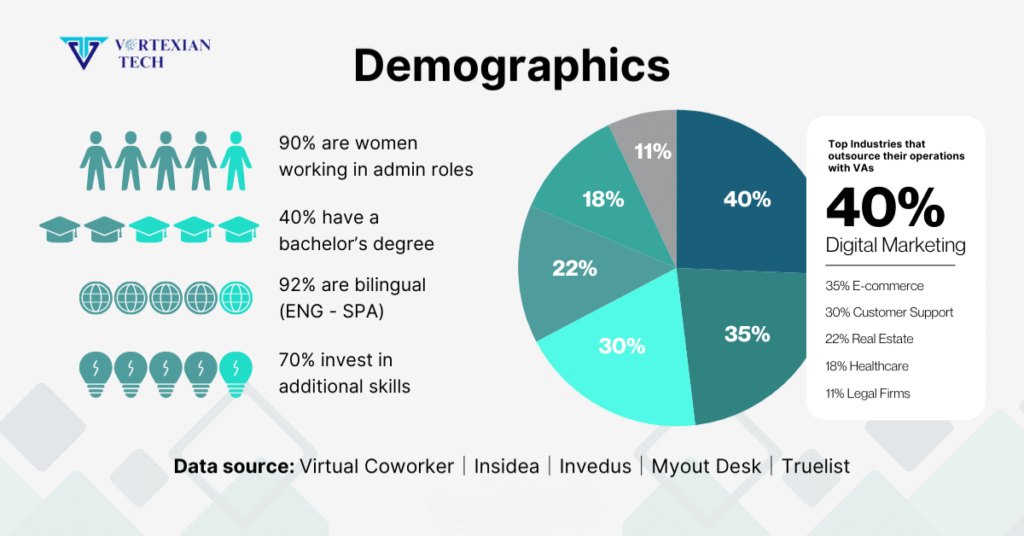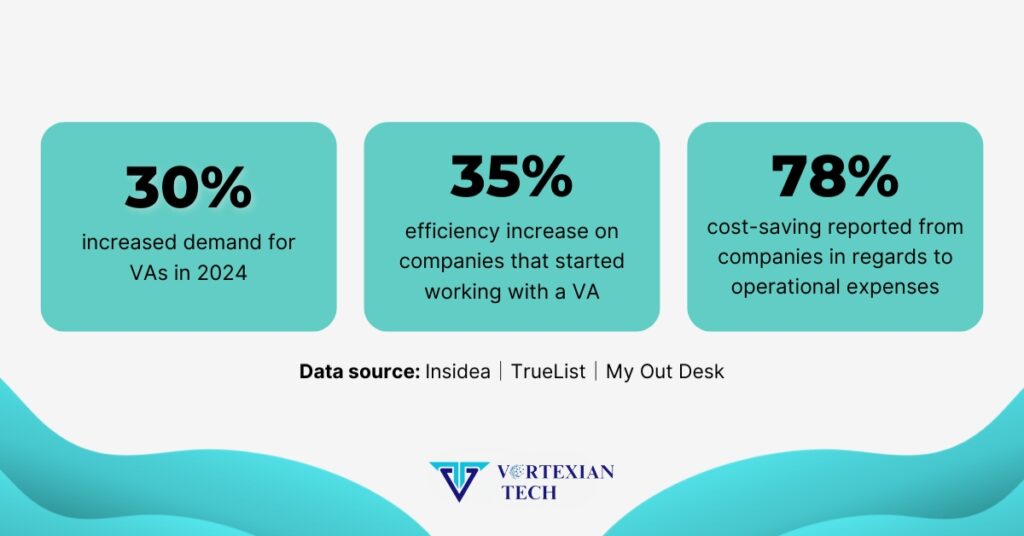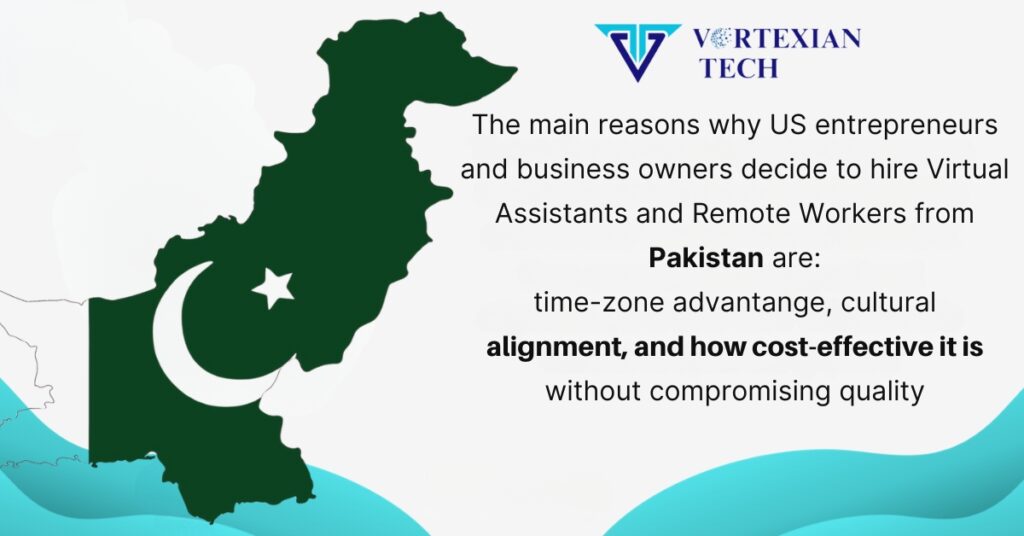Virtual assistants (VAs) have changed the way businesses work, offering flexibility, cost savings and special skills to entrepreneurs and enterprises. With the rise of remote work and technology, the VA industry has grown exponentially. Here are the latest stats and insights to help you understand this booming industry.

1. Global Growth of the Virtual Assistant Statistics Industry
The VA industry has been quickly expanding across the globe. This is mainly driven by businesses seeking flexible staffing solutions and access to talent worldwide:
- Market Value: The global virtual assistant market is projected to reach $44.25 billion by 2027, reflecting a compound annual growth rate (CAGR) of 20.3%. (World Metrics)
- Demand Surge: The demand for VAs increased by 35% in 2024, driven by the shift to remote work and flexible staffing solutions. (Insidea)
- Global Workforce: There are approximately 40 million VAs worldwide, with significant contributions from regions like Latin America, Asia, and Eastern Europe. (Task Drive)
2. The Productivity Advantage of Hiring Virtual Assistants
Businesses and entrepreneurs have noticed that hiring a VA is not just about getting tasks done, but also about working smarter and freeing up time, so they can focus on growing their operations and getting more clients.
- Productivity Boost: Remote workers, including VAs, are 13% more productive than their in-office counterparts. (Truelist)
- Task Delegation: Entrepreneurs regain an average of 13-15 hours per week by delegating tasks to VAs. (Virtual Assistance Institute)
- Workflow Efficiency: Companies report a 35% increase in efficiency when routine tasks are managed by VAs. (MyOutDesk)
3. Financial Savings with Virtual Assistants
One of the most compelling reasons to hire VAs is the financial advantage, they bring:
- Cost Reduction: Businesses save up to 78% on operational expenses by hiring VAs instead of full-time in-house staff. (Truelist)
- Affordable Talent: Latin American VAs offer professional services starting at $400/month, making them highly cost-effective for U.S.-based businesses. (Insidea)
- Training Costs: Outsourcing to experienced VAs reduces training expenses by 15-25%. (Invedus)

4. The Role of Technology in Virtual Assistance
VAs are leveraging technology to work more efficiently and deliver better results.
- AI Integration: 40% of VAs now use AI tools to optimize tasks like data entry, scheduling, and customer support. (Task Drive)
- Cloud-Based Collaboration: Platforms like Slack, Asana, and Zoom facilitate seamless communication between VAs and their clients. (Insidea)
- Specialized Software: VAs increasingly utilize niche tools for tasks such as digital marketing (HubSpot), bookkeeping (QuickBooks), and graphic design (Canva). (MyOutDesk)
5. Industries Benefiting Most from VAs
Some industries have been adding VAs to their operations more than others, due to the nature of their operations:
- Real Estate: Transaction coordination, lead generation, and social media management are popular tasks delegated to VAs. (MyOutDesk)
- E-commerce: Product listing, order processing, and customer service are frequently outsourced. (Insidea)
- Healthcare: Medical billing, appointment scheduling, and patient follow-ups are efficiently handled by VAs. (Truelist)
6. Top Regions for Virtual Assistant Services
The global VA market thrives in specific regions known for their talent and cost-effectiveness:
- Latin America: Countries like Colombia, Mexico, and Argentina are renowned for bilingual professionals and time zone compatibility with the U.S. (Project Untethered)
- Asia: The Philippines and India dominate the VA market, offering specialized skills at competitive rates. (Invedus)
- Eastern Europe: Nations like Poland and Ukraine are popular for tech-savvy VAs with expertise in IT and software development. (Work Well Remote)
7. Industry Expertise
Virtual assistants are no longer limited to basic administrative work. They have become specialists in almost every field, from Real Estate, E-Commerce, Health Care, Customer Service, Marketing. among other expertises.
- 40% of digital marketing agencies rely on VAs for campaign management (MyOutDesk).
- 35% of e-commerce businesses use VAs for product research (Project Untethered)
- 30% of companies in customer support use virtual assistants to handle their daily operations (MyOutDesk).
- 22% of real estate agents outsource property listings to VAs (Virtual Coworker)
- 18% of healthcare institutions rely on VAs to handle patient scheduling and insurance claims (Invedus)
- 11% of legal firms use VAs for paralegal tasks and case research (US Legal Support)
According to Project Untethered, with 46% of VAs specializing in niche services, hiring a specialized virtual assistant gives you access to skills that would require an entire department.

8. The Earnings of Virtual Assistants
VA salaries vary significantly depending on location, expertise, and client needs:
- U.S.-Based VAs: Earn an average of $50,749 annually, with specialized roles reaching up to $70,000. (MyOutDesk)
- Latin American VAs: Typically earn between $400 and $2,000 monthly, offering excellent ROI for businesses. (Insidea)
- Asian VAs: Rates start as low as $5/hour, making them highly competitive in the global market. (Truelist)
9. Common Tasks Delegated to Virtual Assistants
VAs take on a wide range of responsibilities, freeing up time for business owners to focus on strategic growth:
- Administrative Tasks: Email management, calendar management, and data entry.
- Marketing Support: Social media management, written and visual content creation, and SEO optimization.
- Customer Service: Responding to inquiries, managing complaints, and providing technical support.
- Specialized Roles: Graphic design, bookkeeping, and IT support. (Task Drive)
10. Pakistan VAs: The Nearshore Advantage
For U.S.-based businesses, hiring VAs from From Pakistan offers unique benefits:
- Time Zone Alignment: Shared time zones improve communication and collaboration. (Project Untethered)
- Cultural Similarities: A strong understanding of U.S. business practices and customer preferences. (MyOutDesk)
- Language Proficiency: 92% of Latin American VAs are bilingual, ensuring seamless communication. (Insidea)

Future Trends in the VA Industry
The VA industry is expecting to keep growing in the following years, thanks to AI innovations and platforms that enhance communication:
- Niche Specialization: By 2025, 40% of VAs are expected to offer highly specialized services in fields like IT, legal, and medical support. (Virtual Assistance Institute)
- Hybrid Roles: VAs will increasingly integrate AI tools into their workflows, enhancing efficiency and accuracy. (Task Drive)
- Remote Work Expansion: By 2028, 73% of departments worldwide are expected to employ remote workers. (Work Well Remote)
How to Hire the Right Virtual Assistant
Finding the perfect VA requires careful planning and selection:
- Identify Your Needs: List the tasks you’d like to delegate and prioritize them in order of importance.
- Choose a Reputable Agency: Agencies like Vortexian Tech provide pre-vetted candidates tailored to your requirements.
- Assess Compatibility: Evaluate candidates based on their skills, experience, and cultural alignment with your business. (MyOutDesk)
Conclusion: Why Now Is the Time to Hire a VA
The data speaks for itself: virtual assistants are transforming businesses by boosting productivity, cutting costs, and enabling entrepreneurs to focus on growth.
Whether you’re a startup or a seasoned business owner, leveraging the power of VAs can help you stay competitive in today’s fast-paced market.
Ready to find the perfect VA? Schedule a free consultation with Vortexian Tech today and access top candidates from Pakistan to support your business needs.
FAQs – Virtual Assistant Statistics 2025: Insights and Trends
By 2025, the global virtual assistant market is expected to surpass $30 billion, driven by increased demand for remote work solutions, AI advancements, and business scalability needs.
Industries like digital marketing, e-commerce, healthcare, real estate, and finance are expected to lead virtual assistant adoption, using VAs for customer service, marketing automation, and administrative support.
AI is set to make virtual assistants more autonomous, proactive, and predictive, enabling them to handle complex tasks such as campaign analysis, client onboarding, and real-time decision-making with minimal human intervention.
Surveys predict that nearly 60% of small to mid-sized businesses will have integrated at least one virtual assistant into their operations by 2025, either as freelancers or through specialized agencies.
The most sought-after skills will include social media management, SEO optimization, project management, CRM operations, and AI tool proficiency, making virtual assistants even more valuable strategic assets.

